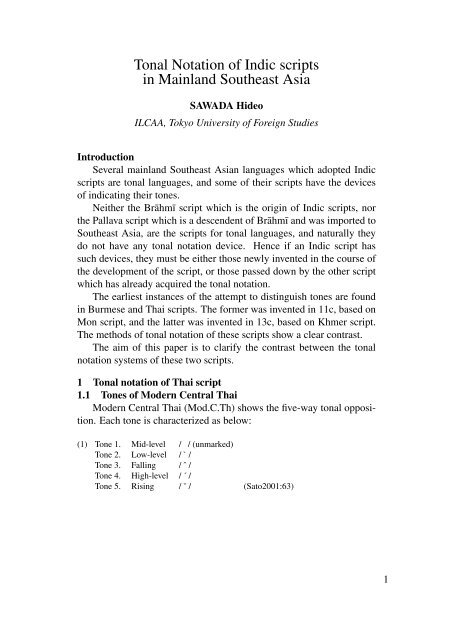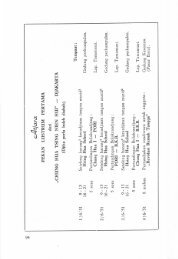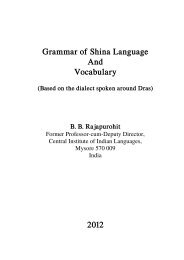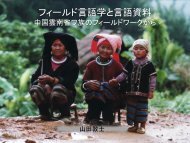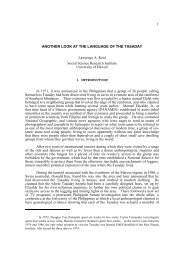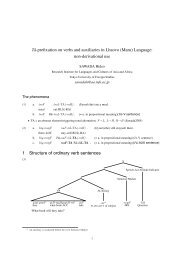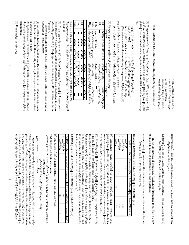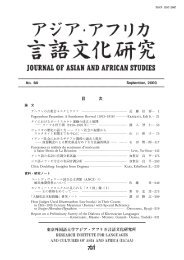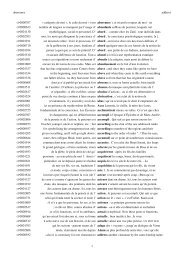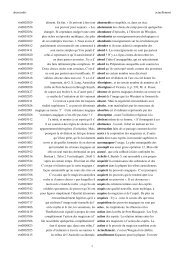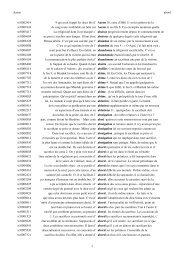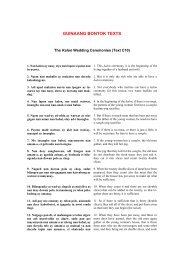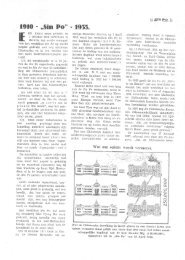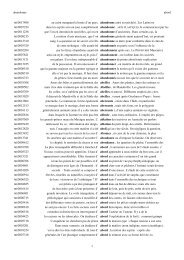Tonal Notation of Indic scripts in Mainland Southeast Asia
Tonal Notation of Indic scripts in Mainland Southeast Asia
Tonal Notation of Indic scripts in Mainland Southeast Asia
You also want an ePaper? Increase the reach of your titles
YUMPU automatically turns print PDFs into web optimized ePapers that Google loves.
<strong>Tonal</strong> <strong>Notation</strong> <strong>of</strong> <strong>Indic</strong> <strong>scripts</strong><br />
<strong>in</strong> Ma<strong>in</strong>land <strong>Southeast</strong> <strong>Asia</strong><br />
SAWADA Hideo<br />
ILCAA, Tokyo University <strong>of</strong> Foreign Studies<br />
Introduction<br />
Several ma<strong>in</strong>land <strong>Southeast</strong> <strong>Asia</strong>n languages which adopted <strong>Indic</strong><br />
<strong>scripts</strong> are tonal languages, and some <strong>of</strong> their <strong>scripts</strong> have the devices<br />
<strong>of</strong> <strong>in</strong>dicat<strong>in</strong>g their tones.<br />
Neither the Brāhmī script which is the orig<strong>in</strong> <strong>of</strong> <strong>Indic</strong> <strong>scripts</strong>, nor<br />
the Pallava script which is a descendent <strong>of</strong> Brāhmī and was imported to<br />
<strong>Southeast</strong> <strong>Asia</strong>, are the <strong>scripts</strong> for tonal languages, and naturally they<br />
do not have any tonal notation device. Hence if an <strong>Indic</strong> script has<br />
such devices, they must be either those newly <strong>in</strong>vented <strong>in</strong> the course <strong>of</strong><br />
the development <strong>of</strong> the script, or those passed down by the other script<br />
which has already acquired the tonal notation.<br />
The earliest <strong>in</strong>stances <strong>of</strong> the attempt to dist<strong>in</strong>guish tones are found<br />
<strong>in</strong> Burmese and Thai <strong>scripts</strong>. The former was <strong>in</strong>vented <strong>in</strong> 11c, based on<br />
Mon script, and the latter was <strong>in</strong>vented <strong>in</strong> 13c, based on Khmer script.<br />
The methods <strong>of</strong> tonal notation <strong>of</strong> these <strong>scripts</strong> show a clear contrast.<br />
The aim <strong>of</strong> this paper is to clarify the contrast between the tonal<br />
notation systems <strong>of</strong> these two <strong>scripts</strong>.<br />
1 <strong>Tonal</strong> notation <strong>of</strong> Thai script<br />
1.1 Tones <strong>of</strong> Modern Central Thai<br />
Modern Central Thai (Mod.C.Th) shows the five-way tonal opposition.<br />
Each tone is characterized as below:<br />
(1) Tone 1. Mid-level / / (unmarked)<br />
Tone 2. Low-level / ` /<br />
Tone 3. Fall<strong>in</strong>g / ˆ /<br />
Tone 4. High-level / ´ /<br />
Tone 5. Ris<strong>in</strong>g / ˇ / (Sato2001:63)<br />
1
1.2 Tone marks <strong>of</strong> Modern Thai Script<br />
Modern Thai script has four tone marks:<br />
(2) 1st tone mark (máy Pèek) Că<br />
2nd tone mark(máy thoo) Cč<br />
3rd tone mark (máy trii) Cę<br />
4th tone mark (máy chàttàwaa) Cľ<br />
The presence <strong>of</strong> either <strong>of</strong> the four tone marks, together with their<br />
absence, dist<strong>in</strong>guish the five tones. However, it is not the case that each<br />
tone mark (<strong>in</strong>clud<strong>in</strong>g unmarked case as hav<strong>in</strong>g ‘zero-mark’) uniquely<br />
marks a tone. Which tone a tone mark marks depends on the ‘group’<br />
the consonant letter belongs. There are three ‘group’ <strong>of</strong> consonant letter,<br />
def<strong>in</strong>ed by the sound it supposedly represented when Thai accepted the<br />
script system. as below:<br />
(3) • Group H: letters supposed to have represented aspirated voiceless stops/affricates,<br />
fricatives, and voiceless sonants<br />
• Group M: letters supposed to have represented non-aspirated voiceless stops/<br />
affricates, glottalized stops, and zero-consonant<br />
• Group L: letters supposed to have represented voiced stops/affricates, and<br />
voiced sonants<br />
Tone marks occur only <strong>in</strong> non-checked syllables, i.e. open rhymes<br />
and closed rhymes end<strong>in</strong>g with a nasal. In checked syllables, the length<br />
<strong>of</strong> vowel functions as a determ<strong>in</strong><strong>in</strong>g factor <strong>of</strong> tone.<br />
The relation <strong>of</strong> the groups <strong>of</strong> <strong>in</strong>itial consonant, tone marks and tones<br />
is summarized below.<br />
(4)<br />
Group H Group M Group L<br />
letters letters letters<br />
unmarked ĂA khǎa kA kaa gA khaa<br />
non-checked 1st tone mark Că ĂăA khàa kăA kàa găA khâa<br />
2nd tone markCč ĂčA khâa kčA kâa gčA kháa<br />
syllables 3rd tone markCę – kęA káa –<br />
4th tone mark Cľ – kľA kǎa –<br />
checked short vowel Ăak khàk kak kàk gak khák<br />
syllables long vowel ĂAk khàak kAk kàak gAk khâak<br />
2
For example, 1st tone mark represents Low-level tone when the consonant<br />
is <strong>of</strong> group M or H, and Fall<strong>in</strong>g tone when the consonant is <strong>of</strong><br />
group L. Fall<strong>in</strong>g tone is represented by 1st tone mark coupled with a<br />
consonant <strong>of</strong> group L, as well as 2nd tone mark with a consonant group<br />
M or H.<br />
Such an <strong>in</strong>tricate system <strong>of</strong> tonal notation is the result <strong>of</strong> the phonological<br />
change which occurred <strong>in</strong> Central Thai after the reception <strong>of</strong><br />
writ<strong>in</strong>g system. The bifurcation <strong>of</strong> tones occured <strong>in</strong> compensation for<br />
the loss <strong>of</strong> opposition <strong>in</strong> voicedness <strong>of</strong> <strong>in</strong>itial consonants, and it complicated<br />
the correspondence between tone marks and tones. (Usami1998:<br />
32–35)<br />
There is no cooccurrence restriction between tone marks and nonchecked<br />
rhymes. In other words, a tone mark is <strong>in</strong>dependent <strong>of</strong> any<br />
non-checked rhymes.<br />
1.3 Tone marks <strong>of</strong> Thai Script <strong>of</strong> the period <strong>of</strong> K<strong>in</strong>g Lithai<br />
The oldest Thai script, called Laisuthai, is said to have been <strong>in</strong>vented<br />
by K<strong>in</strong>g Ramkhamhaeng (reign AD 1279–1317) <strong>of</strong> Sukhothai Dynasty<br />
and realized <strong>in</strong> the <strong>in</strong>scription (AD 1292) attributed to him. Laisuthai is<br />
unique <strong>in</strong> the usage <strong>of</strong> vowel symbols: vowel symbols which are placed<br />
on the top <strong>of</strong> or under the consonant letter <strong>in</strong> all <strong>of</strong> later <strong>in</strong>scriptions are<br />
placed on the left <strong>of</strong> the letter <strong>in</strong> his <strong>in</strong>scription. Yet, <strong>in</strong> other po<strong>in</strong>ts such<br />
as the set <strong>of</strong> consonant letters and their shape, that <strong>of</strong> vowel symbols and<br />
<strong>of</strong> tone marks used, it is almost the same as <strong>in</strong>scriptions <strong>of</strong> the period <strong>of</strong><br />
K<strong>in</strong>g Lithai. (Sato2001:565)<br />
In the period <strong>of</strong> K<strong>in</strong>g Lithai (AD 1354–1376), vowel symbols were<br />
placed just as <strong>in</strong> the modern orthography. There were two tone marks<br />
<strong>in</strong> common with Laisuthai.<br />
(5) 1st tone mark Că<br />
2nd tone mark Cľ<br />
The second tone mark became Cč <strong>in</strong> the period <strong>of</strong> K<strong>in</strong>g Narai (AD 1657–<br />
1688). The four tone marks system like today is found <strong>in</strong> the literature<br />
<strong>in</strong> AD 1732. 1 (Sato2001:567)<br />
Tones were not fully represented <strong>in</strong> texts <strong>in</strong> the period <strong>of</strong> K<strong>in</strong>g Lithai. 2<br />
In Nakhon Chun Inscription (AD 1357), we f<strong>in</strong>d many <strong>in</strong>stances where<br />
the tone marks which should be present are <strong>in</strong> fact omitted. Below is<br />
the list <strong>of</strong> frequent words unaccompanied by the necessary tone mark <strong>in</strong><br />
all or many <strong>of</strong> their occurrence.<br />
(6) numerals: /rÓOy/ ‘hundred’ (2nd tone mark); /sìi/ ‘four’ (1st);<br />
3
‘Heavy’ and ‘Creaky’: these names should always be complemented<br />
with the phrase ‘the tonal class correspond<strong>in</strong>g to ... <strong>of</strong> Mod.B’.<br />
2.2 <strong>Tonal</strong> dist<strong>in</strong>ction <strong>in</strong> the current Burmese orthography<br />
The three tones are fully dist<strong>in</strong>guished for each rhyme <strong>in</strong> Modern<br />
Burmese script. However, the system <strong>of</strong> tonal notation is not so ‘systematic’<br />
as that <strong>of</strong> Thai script. Below are the examples with <strong>in</strong>itial consonant<br />
/k-/.<br />
(9) /-a/ /-i/ /-u/ /-e/<br />
/Level/ kA {kaa} k¯ {kii} kU {kuu} ek {ke}<br />
/Heavy/ kA:{kaa:} k¯:{kii:} kU:{kuu:} ek:{ke:}<br />
/Creaky/ k {ka} k˘ {ki} ku {ku} ekä< {ke.}<br />
/-E/ /-O/ /-o/ /-Vð/<br />
/Level/ k`y¸{kay’} ekA’{ko’} kui<br />
{kui} kN¸ {VN} etc.<br />
/Heavy/ k`X<br />
{kaY} ekA{ko} kui:{kui:}<br />
kN¸:{VN:} etc.<br />
/Creaky/ k`Xä<br />
{kaY.} ekAä
2.3 Correspondence between modern and Mahathenapati Anandathura<br />
Maunghnan Inscription’s spell<strong>in</strong>gs<br />
The <strong>in</strong>tricate tonal notation system <strong>of</strong> Burmese script shown above<br />
is partly due to the diachronic change it has suffered s<strong>in</strong>ce its birth. In<br />
the earliest stage <strong>of</strong> the script, how were the tonal opposition reflected<br />
<strong>in</strong> spell<strong>in</strong>gs?<br />
The oldest Burmese <strong>in</strong>scriptions <strong>in</strong> existence are <strong>of</strong> the early 12th<br />
century. Inscriptions <strong>of</strong> the period <strong>in</strong>clud<strong>in</strong>g famous Rajakumar (Myazedi)<br />
Inscription (AD 1112) show spell<strong>in</strong>g variance. It seems to be the late<br />
12c or the early 13c when Burmese orthography was established for the<br />
first time.<br />
Nishi (1999b) refers as the best model <strong>of</strong> the standard OB (=Old<br />
Burmese) orthography to the first pillar <strong>of</strong> Mahathenapati Anandathura<br />
Maunghnan Inscription (Great General Anandathura and His Consort<br />
Inscription) <strong>of</strong> four faces (585–7 ME/AD 1223–5), now <strong>in</strong> the <strong>in</strong>scription<br />
shed <strong>of</strong> Lehmyethna Temple <strong>in</strong> Bagan. 6 Despite the length <strong>of</strong> 229<br />
l<strong>in</strong>es, the <strong>in</strong>scriptions show the strik<strong>in</strong>g consistency <strong>in</strong> spell<strong>in</strong>g.<br />
Below we show the spell<strong>in</strong>gs <strong>of</strong> non-checked rhymes <strong>of</strong> Mod.B and<br />
the correspond<strong>in</strong>g spell<strong>in</strong>gs <strong>of</strong> Anandathura Inscription.<br />
(11) Mod.B Mod.B Anandathura<br />
sounds spell<strong>in</strong>gs spell<strong>in</strong>gs 7<br />
/-a(L)/ ßA {-aa}<br />
/-a(H)/ ßA: {-aa:}<br />
ßA {-aa}<br />
/-a(C)/ ß {-a} ß {-a}<br />
/-i(L)/ ߯ {-ii}<br />
/-i(H)/ ߯: {-ii:}<br />
߯ {-ii}<br />
/-i(C)/ ߢ {-i} ߢ {-i}<br />
/-u(L)/ ßU {-uu}<br />
/-u(H)/ ßU: {-uu:}<br />
ßU {-uu}<br />
/-u(C)/ ßu {-u} ßu {-u}<br />
/-E(L)/ ßy¸ {-ay’} ßy¸{-ay’} | ßAy¸{-ay’}<br />
/-E(H)/ ߲ {-aY} ßy¸{-ay’}<br />
/-E(C)/ ߲ä< {-aY.} ßy¸<br />
a {-ay=@’}<br />
6
-o(L)/ ßui<br />
{-ui}<br />
/-o(H)/ ßui:<br />
{-ui:}<br />
ßuiw¸<br />
{-uiw’}<br />
/-o(C)/ ßui.<br />
{-ui.} ßuiw¸<br />
a {-uiw=@’}<br />
(When {V}={a} ex. ßN¸{-ang’})<br />
/-Vð(L)/ ßN¸ {-ang’} ßN¸ {-ang’} | ßAN¸{-aang’}<br />
/-Vð(H)/ ßN¸: {-ang’:} ßN¸ {-ang’}<br />
/-Vð(C)/ ßN¸ä< {-ang’.} ßN¸<br />
a {-ang=@’}<br />
/-Vð(L)/ ߢn’ {-<strong>in</strong>’}<br />
(When {V}={i,u,o,ui}) ex. ߢn’{-<strong>in</strong>’})<br />
/-Vð(H)/ ߢn’: {-<strong>in</strong>’:}<br />
ߢn’ {-<strong>in</strong>’}<br />
/-Vð(C)/ ߢn’. {-<strong>in</strong>’.} ߢӒ<br />
a {-<strong>in</strong>=@’}<br />
/-e(L)/ eß {-e}<br />
/-e(H)/ eß: {-e:}<br />
ߢy¸{-iy’}<br />
/-e(C)/ eßä {-e.} ߢy¸<br />
a {-iy=@’} | ęa¸ {-e@’}<br />
/-O(L)/ eßA’{-o’} ßw¸ {-aw’} | ßAw¸{-aaw’} | eßA{-o}<br />
/-O(H)/ eßA{-o} ßw¸ {-aw’}<br />
/-O(C)/ eßAä
pÇáa¸ {plu@’} ‘do, make’ (Nabaydaw Temple Inscription (early<br />
12c): 7–9. Shwekuncha Temple Inscription<br />
(AD 1223), South face: 32.)<br />
cf. pÇá {plu} (Anandathura A: 2, 7, 9–10, 12, 14–<br />
15, 18–21, 23, 25–30.)<br />
Kua¸ {khu@’} ‘CLASSIFIER’ (Nabaydaw: 9. Tuy<strong>in</strong>hpahto B: 10.)<br />
cf. Ku {khu} (Anandathura A: 1, 13–14, 53–54; B:<br />
1, 31; C: 1; D: 1, 17, 30. Ahtawlat<br />
B:17.)<br />
Provided that both ‘Creaky-sensitive’ <strong>in</strong>scriptions and ‘non Creakysensitive’<br />
<strong>in</strong>scriptions are found <strong>in</strong> a fairly limited area and period, and<br />
the evidence from the tonal correspondence with other Burmish languages,<br />
it is unlikely that the two types <strong>of</strong> ‘sensitivity’ reflect the difference<br />
<strong>of</strong> tonal system. They simply reflect the difference <strong>of</strong> attitude<br />
toward transcrib<strong>in</strong>g sounds.<br />
2.4.1 ß`’<br />
{-@’} <strong>in</strong> phonologically open rhymes<br />
Nishi (1999c) argues that {-@’} and ‘short’ vowels represented the<br />
glottal stop <strong>in</strong> OB and it was later weakened to the creaky phonation <strong>of</strong><br />
the preced<strong>in</strong>g vowel. (p.53) Nishi (1999b) mentions another <strong>in</strong>terpretation<br />
<strong>of</strong> {-@’}, i.e. it <strong>in</strong>dicates laryngealization, as well as the former<br />
<strong>in</strong>terpretation. (p.24)<br />
S<strong>in</strong>ce Mod.B a {@a} as an <strong>in</strong>itial consonant letter represents /P-<br />
/, it is highly probable that OB {@a} also represented /P-/, and OB ß`’<br />
{-@’} aga<strong>in</strong> represented a f<strong>in</strong>al glottal stop or laryngealization <strong>of</strong> the<br />
preced<strong>in</strong>g vowel.<br />
To support his argument, Nishi (1999c) quotes Pulleyblank(1963)’s<br />
comment on Mon usage. (p.53)<br />
‘One can possibly expla<strong>in</strong> the spell<strong>in</strong>g convention <strong>in</strong> terms <strong>of</strong> Mon usage,<br />
<strong>in</strong> which the short vowels were always accompanied by a f<strong>in</strong>al<br />
glottal stop when not followed by any other f<strong>in</strong>al consonant and the fi-<br />
nal long vowel signs were used only for open syllables <strong>in</strong> foreign loan<br />
words. In Old Burmese a small a was used as a marker for the f<strong>in</strong>al<br />
glottal stop (=creaky tone).’ (Pulleyblank1963:215)<br />
Accord<strong>in</strong>g to a footnote <strong>in</strong> Pulleyblank (1963), he obta<strong>in</strong>ed comments<br />
and advice about problems <strong>of</strong> the Burmese and Mon writ<strong>in</strong>g<br />
9
treated as rhymes with a f<strong>in</strong>al consonant cluster. However, Mon script<br />
provided no device for it, because there has been no f<strong>in</strong>al cluster <strong>in</strong> Mon.<br />
Mon script utilizes the vowel killer obligatorily to transcribe f<strong>in</strong>al<br />
consonants 11 . Therefore, the existance <strong>of</strong> a vowel killer implies that<br />
the syllable is ‘closed’ there. Burmese seems to have taken over the<br />
implication coupled with the obligatory use <strong>of</strong> the vowel killer, because<br />
Burmese did not use two concatenated consonant letters with a vowel<br />
killer each to achive the ‘graphical f<strong>in</strong>al cluster’. Instead, they achieved<br />
it by the comb<strong>in</strong>ation <strong>of</strong> a vowel killer with a ligature.<br />
Most <strong>of</strong> <strong>Indic</strong> <strong>scripts</strong> have a set <strong>of</strong> ligatures, i.e. comb<strong>in</strong>ations <strong>of</strong><br />
consonantal glyphs transcrib<strong>in</strong>g a consonant cluster. In <strong>Indic</strong> <strong>scripts</strong> <strong>of</strong><br />
<strong>Southeast</strong> <strong>Asia</strong>, consonantal glyphs <strong>in</strong> a comb<strong>in</strong>ation are usually dist<strong>in</strong>ct<br />
from each other, 12 and stacked vertically. 13 The <strong>in</strong>herent vowel <strong>of</strong> a letter,<br />
so to speak, is ‘killed’ by the addition <strong>of</strong> a subscript letter. Ligatures<br />
are used to transcribe <strong>in</strong>tersyllabic clusters <strong>of</strong> Sanskrit/Pāli loanwords,<br />
and the <strong>in</strong>trasyllabic clusters.<br />
Old Mon script also has the device <strong>of</strong> ligatures to transcribe consonant<br />
clusters. 14 Some comb<strong>in</strong>ations are the <strong>in</strong>novation <strong>of</strong> Mon script<br />
to transcribe clusters unique to the language, not found <strong>in</strong> Sanskrit/Pāli<br />
loanwords.<br />
(17) l N im¸ {l=ngim’} ‘thousand’ (Rajakumar: 2.)<br />
sťát˘ {s=cu ti} ‘die’ (hypothetical form) (Rajakumar: 11.)<br />
cÁAm¸ {c=naam’} ‘year’ (Rajakumar: 2.)<br />
kÆ<strong>in</strong>’<br />
{k=m<strong>in</strong>’} ‘rule’ (Rajakumar: 10.)<br />
m ân’ {m=Suun’} ‘five’ (Shwezigon A: 31.)<br />
•<br />
k a im¸ {k=@im’} ‘smile’ (Shwezigon A: 20, 21.)<br />
ec a N¸ {c=@eng’} ‘other’ (Rajakumar: 31.)<br />
es a Ar’ {s=@or’} ‘cause’ (hypothetical form) (Shwezigon B: 52.)<br />
As seen <strong>in</strong> the above examples, a vowel symbol attached to a ligature<br />
always modifies the lower glyph <strong>of</strong> it. The same th<strong>in</strong>g must apply to a<br />
vowel killer. When a vowel killer {-’} attached to a ligature conta<strong>in</strong><strong>in</strong>g<br />
a subscript {@}, the <strong>in</strong>herent vowel <strong>of</strong> upper consonant letter is ‘killed’<br />
by the addition <strong>of</strong> the subscript, and the <strong>in</strong>herent vowel <strong>of</strong> subscript is<br />
‘killed’ by {-’}. As a result we get a ‘graphical f<strong>in</strong>al cluster’. Compare<br />
the below examples from OM and OB.<br />
(18)<br />
12
• Rajakumar Inscription, pillar A (474 ME/AD 1113), Burmese<br />
face:<br />
{teh’} ‘EMPHATIC’ (l. 9, 11, 14, 17, 19, 21, 22, 26, 30, 35, 38.);<br />
{ta mu leh’} ‘as for’ (l.7.); {rwoh’} ‘village’ (l.8, 11, 19, 30–32.)<br />
cf. (<strong>in</strong>stances <strong>of</strong> open rhyme <strong>in</strong> Heavy tone represented by ‘long’ vowel symbols)<br />
{paay’ma yaa} ‘queen’ (l. 5, 7, 9–11, 15.); {saa} ‘son’ (l.7, 12, 15, 27,<br />
33, 36.);<br />
{mang’grii} ‘great k<strong>in</strong>g’ (l.16.); {brii ra kaa} ‘after –<strong>in</strong>g’ (l.3, 27, 29.); {phuu}<br />
‘behold’ (l.39.)<br />
• Amatkyi-The<strong>in</strong>gadhur Inscription, obverse (552 ME/AD 1190):<br />
{soh’} ‘ATTRIBUTIVE MARKER’ (l.3, 4.)<br />
cf. {kraa} ‘<strong>in</strong>-between’ (l.14.); {mi yaa} ‘wife’ (l.22.); {saa} ‘son’ (l.23);<br />
{krii} ‘big, great’ (l.1, 2, 13, 16, 21.); {so} ‘ATTRIBUTIVE MARKER’ (l.3, 4,<br />
6, 7, 12–16, 26–29.)<br />
• Inscription about the dedication <strong>of</strong> Tripitaka {pi Ta kat’ lhuu so<br />
kyok’caa} (559 ME/AD 1197):<br />
{@ah’} ‘power?’ (<strong>in</strong> a woman’s name) (l.5.)<br />
cf. {miy=yaa} ‘wife’ (l.8, 13, 14.); {may=yaa} ‘wife’ (l.5, 10, 13, 15, 16.);<br />
{myaa} ‘wife’ (l.9.); {ku laa} ‘Indian?’ (<strong>in</strong> a woman’s name) (l.8.); {saa}<br />
‘son’ (l.5.)<br />
• Inscription No. 22, Inscription shed, Mandalay Palace (560 ME/AD<br />
1198):<br />
{teh’} (l.1.)<br />
cf. {nwaa} ‘cow’ (l.8, 24.); {saa} ‘son’ (l.6.); {te} (l.15.); {so} ‘ATTRIBUTIVE<br />
MARKER’ (l.2, 3, 7, 8, 10–13, 17–19, 21–23.)<br />
• Th<strong>in</strong>-Ngahnitloth<strong>in</strong> Inscription, reverse (568 ME/AD 1206):<br />
{phyak’chiih’} ‘destroy, ru<strong>in</strong>’ (the vowel symbol is exceptional)<br />
(l.24.); {soh’} ‘ATTRIBUTIVE MARKER (l.24.)<br />
cf. {nwaa} ‘cow’ (l.12.); {myaa} ‘wife’ (l.6.); {saa} ‘son’ (l.4, 5, 6, 9.);<br />
{su krii} ‘headman’ (l.14, 24.); {phyak’chii} ‘destroy, ru<strong>in</strong>’ (l.14–15.)<br />
• Saw-Yahan-The<strong>in</strong> Inscription (574 ME/AD 1212):<br />
{puih’} ‘<strong>in</strong>sect?’ (<strong>in</strong> a man’s name) (l.3.)<br />
cf. {kraa ra kaa} ‘when (he) heard’ (l.5.); {mang’krii} ‘great k<strong>in</strong>g’ (l.4, 5.);<br />
{prii} ‘f<strong>in</strong>ish’ (l.13.); {kwaM sii} ‘betel nut’ (l.20, 21.)<br />
16
The <strong>in</strong>stances <strong>of</strong> {-:} {-:}, Mon-Burmese version <strong>of</strong> visarga, also appears<br />
<strong>in</strong> the spell<strong>in</strong>g <strong>of</strong> open rhymes <strong>in</strong> Heavy tone, though Ahtawlat<br />
Inscription has no <strong>in</strong>stances <strong>of</strong> it. {-:} is usually used <strong>in</strong> comb<strong>in</strong>ation<br />
with ‘long’ vowel symbols, not ‘short’. {-:} appears more <strong>of</strong>ten than<br />
{-h’}, but its occurrence is still sporadic. {-:} cooccur also with {-e},<br />
but not {-o}.<br />
• Sakhiphuna Inscription (530 ME/AD 1168):<br />
{@aa:} ‘TEMPORAL’ (l.2, 3); {sa:} ‘son’ (with an exceptional<br />
vowel symbol) (l.4, 5);<br />
• Th<strong>in</strong>gyi-Ngana<strong>in</strong>gth<strong>in</strong> Inscription (555 ME/AD 1193):<br />
{phwaa:} ‘be born’ (<strong>in</strong> a women’s name) (l.7); {@aa:} ‘TEMPO-<br />
RAL’ (l.10); {te:} ‘EMPHATIC’ (l.12, 14, 15)<br />
cf. {kaa} ‘CONTRASTIVE’ (l.10,13); {pu rhaa} ‘Buddha, pagoda’ (l.1, 5, 11)<br />
• Th<strong>in</strong>gyi-Nyaung-ot Inscription (563 ME/AD 1201):<br />
{kaa:} ‘CONTRASTIVE’ (obverse:22); {pu rhaa:} ‘Buddha, pagoda’<br />
(obverse:17, reverse:11, 12); {tan’thaa:} ‘bridge’ (r.:4); {@aa:}<br />
‘TEMPORAL’ (r.:12)<br />
cf. {kaa} (o.:6, 10, 19, r.:11); {kraa} ‘hear’ (o.:10, 13, 15); {pu rhaa} (r.:1);<br />
{saa} ‘son, man’ (o.:8, 15, r.:19); {@aa} ‘to’ (o.:19); {krii} ‘big, great’ (o.:14,<br />
15, r.:19); {prii} ‘f<strong>in</strong>ish’ (r.:1, 2, 3); {mii} ‘fire’ (r.:3, 5)<br />
• Th<strong>in</strong>-Ngahnitloth<strong>in</strong> Inscription, reverse<br />
{@aa:} ‘TEMPORAL’ (l.2)<br />
• Ngasanth<strong>in</strong> Inscription (570 ME/AD 1208):<br />
{te:} ‘EMPHATIC’ (l.9, 10–11)<br />
cf. {kaa} ‘CONTRASTIVE’ (l.8, 9, 10, 11); {nwaa} ‘cow’ (l.9,17); {mi yaa}<br />
‘wife’ (l.10, 18, 19, 20); {pu rhaa} ‘pagoda’ (l.8–9, 18); {saa} ‘son’ (l.5);<br />
{@aa} ‘TEMPORAL’ (l.2); {te} (l.16, 18, 20, 21)<br />
• Saw-Yahan-The<strong>in</strong> Inscription:<br />
{pyaa:} ‘bee’ (l.26)<br />
• Ngatath<strong>in</strong> Inscription (587 ME/AD 1225):<br />
{@a:} ‘<strong>in</strong>terjectory sentence f<strong>in</strong>al particle’ (with an exceptional<br />
vowel symbol) (l.18)<br />
cf. {kaa} ‘CONTRASTIVE’ (l.4, 6, 7, 12, 18, 19); {kraa} ‘hear’ (l.7,12);<br />
{miy’yaa} ‘wife’ (l.4, 5, 6); {pu rhaa} ‘Buddha’ (l.6–7); {saa} ‘man’ (l.12)<br />
17
2.5.3 What the ‘marked’ notations aim at?<br />
{-h’}/{-:} Nishi (1999b,c) counts {-h’} and {-:}, like {-@’}, as represent<strong>in</strong>g<br />
tonal dist<strong>in</strong>ctions. He assumes that both {-h’} and {-:} represented<br />
the phonation type <strong>of</strong> the preced<strong>in</strong>g vowel, not the segmental<br />
{-h’}, and that the contrast between tones 1 and 2 must have been<br />
phonatory at the stage <strong>of</strong> Pre-OB, which was later transphonologized to<br />
pitch contrast <strong>in</strong> OB. (Nishi1999c:p.52)<br />
As for the fact that they are found only with open rhymes, he gives<br />
three possible <strong>in</strong>terpretations below:<br />
first, breath<strong>in</strong>ess was not very conspicuous for the non-open vocalic<br />
and nasal rhymes;<br />
second, when Burmese began to be graphized, the tonal contrast <strong>of</strong><br />
tones 1 and 2 was not that <strong>of</strong> pitch, but that <strong>of</strong> both the phonatory features,<br />
clear/normal (or modal) voice and breathy voice (or murmured<br />
voice), and the pitch registers, high and low(/mid) for open rhymes, to<br />
an extent that it was difficult even for the OB speakers to decide that<br />
either one <strong>of</strong> the features was less significant (or redundant), ...;<br />
and third, the contrast <strong>in</strong> pitch was already established, but the breathy<br />
phonation <strong>of</strong> tone 2 rema<strong>in</strong>ed as its redundant feature though still phonetically<br />
conspicuous for open rhymes. (Nishi1999b:p.59)<br />
It is prausible enough that {-h’} and {-:} transcribed the breath<strong>in</strong>ess<br />
<strong>in</strong> OB. However, Nishi’s argument that {-h’}/{-:} were meant to represent<br />
tonal dist<strong>in</strong>ction, i.e. to dist<strong>in</strong>guish Heavy tone from others is open<br />
to question. As far as we see the limited occurrence <strong>of</strong> {-h’}/{-:} even<br />
<strong>in</strong> open rhymes. we can never say that the tonal dist<strong>in</strong>ction between<br />
Heavy tone and others is systematically reflected <strong>in</strong> spell<strong>in</strong>gs.<br />
As mentioned <strong>in</strong> 2.1, It is clear that there were already three dist<strong>in</strong>ctive<br />
tones <strong>in</strong> the stage <strong>of</strong> Old Burmese. OB spell<strong>in</strong>gs do not dist<strong>in</strong>guish<br />
Heavy rhymes from Level rhymes <strong>in</strong> most cases, maybe because the<br />
pr<strong>in</strong>cipal phonetic feature dist<strong>in</strong>guish<strong>in</strong>g Heavy tone from Level tone<br />
could not be represented by any glyphs exist<strong>in</strong>g <strong>in</strong> Mon script, and/or<br />
because Burmese people <strong>of</strong> the time usually did not feel the necessity<br />
<strong>of</strong> represent<strong>in</strong>g the feature. Rhymes <strong>in</strong> Heavy tone were spelled with<br />
{-h’} and {-:} when breath<strong>in</strong>ess, which was a concomitant feature <strong>of</strong><br />
the tone, was very conspicuous enough to draw the hearer’s attention.<br />
{-h’} and {-:} do not occur <strong>in</strong> spell<strong>in</strong>gs <strong>of</strong> closed rhymes 18 , seldom<br />
occur <strong>in</strong> open rhymes with {-i} and {-u} which represent close vowels,<br />
and not always occur even <strong>in</strong> open rhymes with {-a} and {-e} represent<strong>in</strong>g<br />
vowels with high degree <strong>of</strong> aperture. The facts are expla<strong>in</strong>ed<br />
if we assume that breath<strong>in</strong>ess <strong>of</strong> a vowel <strong>in</strong> OB <strong>in</strong>creased its <strong>in</strong>tensity<br />
toward the end <strong>of</strong> the vowel.<br />
22
(29) {-a} {-aa}<br />
/-a/ /-ai/ with {-k’}, {-ng’}<br />
/-O/ /-a/ with {-c’},{-N˜’},{-t’},{-n’},{-p’},{-m’},{-r’},{-l’},{-s’}<br />
— /-a/ with {-y’}, {-w’}<br />
/-a/ — with {-@’}, {-h’}<br />
(/-aP/) 19 /-a/ without any f<strong>in</strong>al consonant<br />
If Burmese <strong>of</strong> the time had determ<strong>in</strong>ed the usage <strong>of</strong> {-a} and {-aa}<br />
<strong>in</strong> reference to the phonogramic relation between Mon script and the<br />
sound <strong>of</strong> Mon language, it would lead us to an improbable consequence<br />
that such pairs as {taang’}/{tang’} ‘put’, {kaan’}/{kan’} ‘pond’ do not<br />
represent an identical syllable.<br />
To clear the problem, we must assume that the phonogramic relation<br />
<strong>of</strong> Mon script referred <strong>in</strong> determ<strong>in</strong><strong>in</strong>g the spell<strong>in</strong>gs for these OB<br />
sounds is not to Mon sounds, but to Pāli sounds, as far as Shorto’s reconstruction<br />
is correct. It does not necessarily mean that Burmese did<br />
not make reference to the phonogramic relation between Mon script<br />
and Mon sounds at all. It must have been referred <strong>in</strong> such cases as f<strong>in</strong>al<br />
glottal stop we saw <strong>in</strong> 2.4.1.<br />
Another potential problem is that the <strong>in</strong>terpretation might cause the<br />
<strong>in</strong>conformity between OB and Mod.B situations: <strong>in</strong> Mod.B, a syllable<br />
<strong>in</strong> Heavy tone is usually heard longer than the same syllable <strong>in</strong> Level<br />
tone. But it might not constitute a problem, because it is not always the<br />
case that the phonetic feature <strong>of</strong> a tone ma<strong>in</strong>ta<strong>in</strong>s throughout its history.<br />
2.6 Development <strong>of</strong> tone marks after 13c<br />
2.6.1 From ß`’<br />
{-@’} to ßä {-.}<br />
The spell<strong>in</strong>gs for /-a/, /-i/, /-u/ <strong>in</strong> Creaky tone were unified <strong>in</strong>to {-a},<br />
{-i}, {-u} by around 600 ME (AD 1238). The occurrence <strong>of</strong> {-@’} is<br />
limited to closed rhymes, with exception <strong>of</strong> ęa¸ {-e@’} ‘SENTENCE<br />
MARKER/ GENITIVE MARKER’.<br />
a {@} <strong>of</strong> Bagan period had the shape like H. When used as a subscript,<br />
its horizontal stroke tends to be omitted. The <strong>in</strong>stances <strong>of</strong> {@}<br />
without the horizontal stroke is already seen <strong>in</strong> the obverse <strong>of</strong> Ta<strong>in</strong>gchut<br />
Temple Inscription (541 ME/AD 1179), but it aga<strong>in</strong> is around 600 ME<br />
when the shape <strong>of</strong> {@} became popular.<br />
The balance <strong>of</strong> ‘Creaky-sensitive’ <strong>in</strong>scriptions and ‘non Creakysensitive’<br />
<strong>in</strong>scriptions began to be lost after 600 ME. Which marked<br />
a turn<strong>in</strong>g po<strong>in</strong>t is a series <strong>of</strong> Inscriptions <strong>of</strong> K<strong>in</strong>g Kyazwa’s Royal Order<br />
dated 611 ME (AD 1249), found at several places <strong>of</strong> Upper Burma.<br />
After that, ‘non Creaky-sensitive’ <strong>in</strong>scriptions became the ma<strong>in</strong>stream,<br />
24
2.6.2 The regularization <strong>of</strong> ß: {-:}<br />
{-h’} became unused <strong>in</strong> spell<strong>in</strong>gs <strong>of</strong> open rhyme <strong>in</strong> Heavy tone <strong>in</strong><br />
the middle <strong>of</strong> 13c. Also ‘long’ vowel symbols became obsolete <strong>in</strong> the<br />
late 13c. Though the <strong>in</strong>stances <strong>of</strong> {-:} are attested also <strong>in</strong> <strong>in</strong>scriptions<br />
after 13c, its occurrence is sporadic as before.<br />
The ‘<strong>in</strong>difference’ <strong>of</strong> the script to Heavy tone began to change <strong>in</strong><br />
Tetkale-Taungkyaung Temple Inscription (873 ME/AD 1511) slightly.<br />
In this <strong>in</strong>scription, open rhymes /-a/ <strong>in</strong> Heavy tone are unexceptionally<br />
written as {-a:}. The same th<strong>in</strong>g is applied to Kaunghmudaw Temple Inscription(998<br />
ME/AD 1636). However, other rhymes than /-a/ <strong>in</strong> Heavy<br />
tone are still <strong>in</strong>dist<strong>in</strong>ctive from those <strong>in</strong> Level tone.<br />
Aga<strong>in</strong>, the first case <strong>of</strong> spread<strong>in</strong>g {-:} to rhymes other than /-a/ is<br />
found <strong>in</strong> the <strong>in</strong>k <strong>in</strong>scription <strong>of</strong> Uy<strong>in</strong>gyi Temple mentioned <strong>in</strong> the previous<br />
section. In the <strong>in</strong>k <strong>in</strong>scription, {-:} cooccurs not only with open<br />
rhymes, but also with closed rhymes. 20<br />
(33) acW`m¸:{@a<br />
cwam’:} ‘ability’ (l.1.)<br />
Tuiw¸:{thVw’:}<br />
‘poke’ (l.6.)<br />
Moreover, the <strong>in</strong>scription is epoch-mak<strong>in</strong>g <strong>in</strong> that {-:} cooccurs with<br />
not ‘short’ but ‘long’ vowel symbols <strong>in</strong> open rhymes.<br />
(34) Ûk¯:{krii:} ‘big, great’ (l.11.)<br />
BurA:{bhu raa:} ‘Buddha’ (l.6, 8, 10.)<br />
aA:Tut¸{@aa:thut’} ‘strive’ (l.1.)<br />
eKYAMKYA:{khyo(k’)khyaa:} 21 ‘be alarmed’ (l.3.)<br />
pYA:{pyaa:} ‘bee’ (l.4.)<br />
TA:{thaa:} ‘put’ (l.8.)<br />
Rp`c¸mHA:{prac’mhaa:} ‘wrong’ (l.10.)<br />
kA:{kaa:} ‘CONTRASTIVE’ (l.12.)<br />
Regrettably, {-:} <strong>in</strong> spell<strong>in</strong>gs <strong>of</strong> open rhymes other than /a/ has not<br />
fully regularized yet.<br />
26
(35) c¯pWA:{cii pwaa:} ‘prosperity’ (l.1.)<br />
nH`luM{nha<br />
luM} ‘heart’ (l.2.)<br />
s˘t`N¸suM{si<br />
tang’suM} ‘(<strong>of</strong> monks) reside at a certa<strong>in</strong> place’ (l.5.)<br />
tuik¸tW`n’{tuik’twan’}<br />
‘urge’ (l.7.)<br />
ekAN¸{kong’} ‘good’ (l. 7,9.)<br />
etAN¸{tong’} ‘ask, beg’ (l.10.)<br />
kYâlW`n’{kyuu<br />
lwan’} ‘violate’ (l.10.)<br />
In the <strong>in</strong>k <strong>in</strong>scription, also the tonal dist<strong>in</strong>ction <strong>of</strong> the open rhymes<br />
/-E/, /-O/ had already been reflected <strong>in</strong> the spell<strong>in</strong>gs. Here we will get<br />
the tonal notation system almost same as <strong>in</strong> modern orthography, with<br />
the difference that {-:} has not been extended to other rhymes yet.<br />
Conclusion<br />
In Modern Thai script, the <strong>in</strong>dication <strong>of</strong> tone class are done exclusively<br />
by a dist<strong>in</strong>ct set <strong>of</strong> tone marks. Indeed one-to-one correspondence<br />
between tone marks and tones was lost due to the tonal bifurcation, but<br />
each tone mark uniquely represents a tone, as far as a s<strong>in</strong>gle group <strong>of</strong><br />
<strong>in</strong>itial consonant is concerned. Tone marks are <strong>in</strong>dependent <strong>of</strong> notations<br />
<strong>of</strong> (non-checked) rhyme.<br />
On the other hand, <strong>in</strong> Burmese script tone classes are <strong>in</strong>dicated<br />
partly by the selection <strong>of</strong> a vowel sign, and partly by the addition <strong>of</strong><br />
a tone mark. Unlike Thai script, the occurrence <strong>of</strong> tone marks depends<br />
on the (non-checked) rhyme.<br />
The difference <strong>in</strong> nature <strong>of</strong> two tonal notation systems stems from<br />
their different provenances. S<strong>in</strong>ce none <strong>of</strong> Thai tone marks f<strong>in</strong>d its<br />
source <strong>in</strong> the Khmer script, they must be newly <strong>in</strong>vented to represent<br />
tones not found <strong>in</strong> Khmer language. Although new members were<br />
added to the set, the nature <strong>of</strong> tone marks has rema<strong>in</strong>ed unchanged.<br />
On the other hand, tone marks <strong>of</strong> Modern Burmese script trace back<br />
to glyphs for segmental sounds <strong>in</strong> Mon script. To transcribe some phonetic<br />
feature <strong>of</strong> a tone, putt<strong>in</strong>g aside whether it is pr<strong>in</strong>cipal or concomitant,<br />
Burmese <strong>of</strong> the time utilized the notation <strong>of</strong> Mon segmental sound<br />
which is heard similarly.<br />
To transcribe the phonetic feature <strong>of</strong> Creaky tone, whether glottal<br />
stop or laryngealization, Burmese script <strong>in</strong>troduced ‘short’ vowel symbols<br />
and/or {-@’} from Mon script, together with variance among them.<br />
To breath<strong>in</strong>ess, the phonetic feature <strong>of</strong> Heavy tone <strong>in</strong> open rhymes, it <strong>in</strong>troduced<br />
{-h’}/{-:} which were used for /-h/ <strong>in</strong> Mon script. 22<br />
27
The consistent use <strong>of</strong> the latter notations is not attested <strong>in</strong> <strong>in</strong>scriptions<br />
until 18c, except {-h’} <strong>in</strong> Ahtawlat Inscription. It suggests that<br />
breath<strong>in</strong>ess was not always conspicuous to hearers, and {-h’}/{-:} simply<br />
transcribed particular <strong>in</strong>stances <strong>of</strong> breath<strong>in</strong>ess discernible to them.<br />
In contrast, ‘short’ vowel symbols are normally used for open rhymes<br />
<strong>in</strong> Creaky tone even <strong>in</strong> ‘non Creaky-sensitive’ <strong>in</strong>scriptions, and {-@’},<br />
though solely <strong>in</strong> ‘Creaky-sensitve’ <strong>in</strong>scriptions, shows the consistent<br />
use unlike {-h’}/{-:}. {-@’} is also extended to the case <strong>of</strong> closed<br />
rhyme, produc<strong>in</strong>g ‘graphical f<strong>in</strong>al clusters’. Those facts suggest that<br />
the Glottal stop/laryngealization as a phonetic feature <strong>of</strong> Creaky tone is<br />
always conspicuous. Under the condition, ‘short’ vowel symbols and<br />
{-@’}, unlike {-h’}/{-:}, can be regarded as the notation <strong>of</strong> a tone. In<br />
Brāhmī script, only vowel symbols for /a/, /i/, /u/ show ‘short’ vs. ‘long’<br />
opposition. That reflects the vocalic system <strong>of</strong> Pāli language which<br />
Brāhmī script was designed for. ‘Aryan vocalic constra<strong>in</strong>t’ as such still<br />
<strong>in</strong>fluences many <strong>Indic</strong> script <strong>in</strong> South and <strong>Southeast</strong> <strong>Asia</strong>.<br />
In most cases, ‘Aryan constra<strong>in</strong>t’ <strong>in</strong>fluences vocalic notation system,<br />
more specifically how to dist<strong>in</strong>guish short vowels and long vowels.<br />
Where there is no graphic ‘short’/‘long’ dist<strong>in</strong>ction available, either<br />
lengthen<strong>in</strong>g symbol or shorten<strong>in</strong>g symbol is <strong>in</strong>troduced. Vocalic notation<br />
system <strong>of</strong> Thai script can be regarded as an <strong>in</strong>stence <strong>of</strong> the latter<br />
case. Here -H , Thai version <strong>of</strong> visarga, functions as shorten<strong>in</strong>g symbol.<br />
(Sato2001:561–2)<br />
(36) V= /a/ /i/ /W/ /u/ /e/ /E/ /o/ /O/ /@/<br />
short /VP/ 23 CH Ci CI Cu eCH ECH oCH eCAH eCqH<br />
long /VV/ CA CŞ CŤq CU eC EC oC Cq eCq<br />
In Burmese script, ‘Aryan constra<strong>in</strong>t’ <strong>in</strong>fluences its tonal notation<br />
system. It is because Burmese accepted Mon script whose vocalic system<br />
was <strong>in</strong>fluenced by ‘Aryan constra<strong>in</strong>t’, and used ‘short’/‘long’ dist<strong>in</strong>ction<br />
<strong>of</strong> vowel symbols as represent<strong>in</strong>g tonal dist<strong>in</strong>ction. It is the<br />
highly unique <strong>in</strong>stance <strong>of</strong> ‘Aryan constra<strong>in</strong>t’.<br />
Notes<br />
1 The occurrence <strong>of</strong> the 3rd and 4th tone marks limited to the case <strong>of</strong> Group M consonants tells us that<br />
they were <strong>in</strong>troduced to transcribe the comb<strong>in</strong>ation <strong>of</strong> a voiceless unaspirated consonant and either Highlevel<br />
tone or Ris<strong>in</strong>g tone, maybe from Ch<strong>in</strong>ese words, which could not be represented by the system <strong>of</strong> the<br />
time.<br />
2 In K<strong>in</strong>g Ramkhamhaeng’s Inscription, tones are represented more consistently than <strong>in</strong>scriptions <strong>in</strong> the<br />
period <strong>of</strong> K<strong>in</strong>g Lithai.<br />
3 Checked rhymes, which end<strong>in</strong>g with a glottal stop, show no opposition <strong>in</strong> tone. Some scholars set up<br />
28
Roman transliteration for OB and OM <strong>scripts</strong><br />
Consonant letters<br />
k` K` g` G` N`<br />
{k-} {kh-} {g-} {gh-} {ng-}<br />
c` ß` j` J`(OB)|jó`(OM) F` | f`<br />
{c-} {ch-} {j-} {jh-} {N˜- |n˜-}<br />
q` Q` z` Z` x`<br />
{T-} {Th-} {D-} {Dh-} {N-}<br />
t` T` d` D` n`<br />
{t-} {th-} {d-} {dh-} {n-}<br />
p` P` b` B` m`<br />
{p-} {ph-} {b-} {bh-} {m-}<br />
y` r` l` w` s`<br />
{y-} {r-} {l-} {w-} {s-}<br />
h` L` w a<br />
{h-} {L-} {B-} {@-}<br />
p` • g` •<br />
{S-} {sh-}<br />
30
Subscript consonant symbols<br />
ßY Rß ß Ç ßW ßH other<br />
sub<strong>scripts</strong><br />
{-y-} {-r-} {-l-} {-w-} {-h-} {=C}<br />
Vowel letters<br />
(a) ć ď<br />
({@a}) {i} {u}<br />
(aA) č ě ę ğ<br />
({@aa}) {ii} {uu} {e} {o}<br />
Vowel symbols<br />
ß ß˘ ßu<br />
{-a} {-i} {-u}<br />
ßA ߯ ßU eß e-A<br />
{-aa} {-ii} {-uu} {-e} {-o}<br />
Symbols participat<strong>in</strong>g <strong>in</strong> rhyme notation<br />
superscript letters anusvāra visarga vowel<br />
killer<br />
ßŢ ß r<br />
ß˙ ß: ߸<br />
{ngˆ} {rˆ} {-M} {-:} {-’}<br />
References<br />
Aung Tho (1972) Old Burmese Inscriptions, Vol 1: 474–600 M.E. (<strong>in</strong> Burmese) Yangon: Department <strong>of</strong><br />
Archaeology, M<strong>in</strong>istry <strong>of</strong> Culture.<br />
Ba Sh<strong>in</strong> (1964) The work on studies <strong>of</strong> Bagan Ink Inscription. (Periodical Report 1) (<strong>in</strong> Burmese) Yangon:<br />
Burma Historical Comission.<br />
Coedes, George (1924) Inscription de Sukhodaya. (Recueil des <strong>in</strong>scriptions du Siam ; pt. 1) Bangkok:<br />
Times Press.<br />
Diffloth, Gerard (1984) The Dvaravati Old Mon language and Nyah Kur. Bangkok: Chulalongkorn University<br />
Press.<br />
Duroiselle, Charles (ed.) (1920) Epigraphia Birmanica: be<strong>in</strong>g lithic and other <strong>in</strong>scriptions <strong>of</strong> Burma. Vol.1,<br />
part 2: Mon Inscriptions I–VIII. Rangoon : Super<strong>in</strong>tendent, Government Pr<strong>in</strong>t<strong>in</strong>g and Stationary.<br />
Duroiselle, Charles (1921) Epigraphia Birmanica: be<strong>in</strong>g lithic and other <strong>in</strong>scriptions <strong>of</strong> Burma. Vol.2, part<br />
31
2: The Tala<strong>in</strong>g plaques <strong>of</strong> the Ananda, plates. Rangoon : Super<strong>in</strong>tendent, Government Pr<strong>in</strong>t<strong>in</strong>g and<br />
Stationary.<br />
Ferlus, Michel (1983) ‘Essai de phonetique historique du môn.’ Mon-Khmer Studies XII: pp.1–90.<br />
Halliday, Robert (1930) ‘Les <strong>in</strong>scriptions môn du Siam.’ BEFEO 30: pp.81–105.<br />
Myanmar Language Comission (ed.) (1994) Myanmar-English Dictionary. Yangon: Department <strong>of</strong> the<br />
Myanmar Language Commission, M<strong>in</strong>istry <strong>of</strong> Education, Union <strong>of</strong> Myanmar.<br />
Nai Pan Hla (2000) Shwezigon Mon Inscription (<strong>in</strong> Burmese) Yangon: Hmwe Publisher.<br />
Nishi, Yoshio (1999a) ‘Medials <strong>in</strong> Burmese.’ Four Papers on Burmese, Toward the history <strong>of</strong> Burmese<br />
(Myanmar language) Tokyo: ILCAA. pp.1–10. (Orig<strong>in</strong>ally <strong>in</strong> M.Hashimoto (ed.) Genetic Relationship,<br />
Diffusion, and Typological Similarities <strong>of</strong> East and <strong>Southeast</strong> <strong>Asia</strong>n Languages. Tokyo: Japan<br />
Society for the Promotion <strong>of</strong> Sciences. pp.15–29. 1976.)<br />
Nishi, Yoshio (1999b) ‘The orthographic standardization <strong>of</strong> Burmese.’ Four Papers on Burmese, Toward<br />
the history <strong>of</strong> Burmese (Myanmar language) Tokyo: ILCAA. pp.11–26. (Orig<strong>in</strong>ally Bullet<strong>in</strong> <strong>of</strong> the<br />
national museum <strong>of</strong> Ethnology (BNME) 22.4: pp.975–999. 1997.)<br />
Nishi, Yoshio (1999c) ‘Old Burmese: toward the history <strong>of</strong> Burmese.’ Four Papers on Burmese, Toward the<br />
history <strong>of</strong> Burmese (Myanmar language) Tokyo: ILCAA. pp.33–54. (Orig<strong>in</strong>ally BNME 23.3: pp.659–<br />
692. 1998.)<br />
Nishida, Tatsuo (1972) A Study <strong>of</strong> the Burmese-Ch<strong>in</strong>ese Vocabulary Mien-Tien-Kuan I-Yu: An Introduction<br />
to Burmese L<strong>in</strong>guistics. Kyoto: Shoka-do.<br />
Nye<strong>in</strong> Maung (1982) Old Burmese Inscriptions, Vol 2: 600–622 M.E. (<strong>in</strong> Burmese) Yangon: Department<br />
<strong>of</strong> Archaeology, M<strong>in</strong>istry <strong>of</strong> Culture.<br />
Nye<strong>in</strong> Maung (1993) Old Burmese Inscriptions, Vol 3: 622–699 M.E. (<strong>in</strong> Burmese) Yangon: Department<br />
<strong>of</strong> Archaeology, M<strong>in</strong>istry <strong>of</strong> Culture.<br />
Nye<strong>in</strong> Maung (1998) Old Burmese Inscriptions, Vol 4: 700–797 M.E. (<strong>in</strong> Burmese) Yangon: Department<br />
<strong>of</strong> Archaeology, M<strong>in</strong>istry <strong>of</strong> Culture.<br />
Nye<strong>in</strong> Maung (1998) Old Burmese Inscriptions, Vol 5: 800–998 M.E. (<strong>in</strong> Burmese) Yangon: Department<br />
<strong>of</strong> Archaeology, M<strong>in</strong>istry <strong>of</strong> Culture.<br />
Pulleyblank E.G. (1963) ‘An Interpretation <strong>of</strong> the vowel systems <strong>of</strong> Old Ch<strong>in</strong>ese and <strong>of</strong> Written Burmese’<br />
<strong>Asia</strong> Major 10(2): pp.200–221.<br />
Shorto, H.L. (1965) ‘The <strong>in</strong>terpretation <strong>of</strong> archaic writ<strong>in</strong>g systems.’ L<strong>in</strong>gua 14: pp.88–97.<br />
Shorto, H.L. (1971) A Dictionary <strong>of</strong> the Mon Inscriptions, from the sixth to the sixteenth centuries. London:<br />
Oxford University Press.<br />
Sato, Hir<strong>of</strong>umi (2001) ‘Thai characters.’ (<strong>in</strong> Japanese) Kono, Ch<strong>in</strong>o and Nishida (ed.) The Sanseido Encyclopaedia<br />
<strong>of</strong> L<strong>in</strong>guistics Vol.7: Scripts and Writ<strong>in</strong>g Systems <strong>of</strong> the World, Tokyo: Sanseido. pp.558–<br />
568.<br />
Sawada, Hideo (2002) ‘Some properties <strong>of</strong> <strong>Indic</strong> <strong>scripts</strong> <strong>of</strong> ma<strong>in</strong>land <strong>Southeast</strong> <strong>Asia</strong> — Exemplification by<br />
Burmese and Thai <strong>scripts</strong> —.” R K Arora, Mahesh Kulkarni, Hemant Darbari (ed.) The Indo-European<br />
Conference on Multil<strong>in</strong>gual Technologies (IEMCT) New Delhi:Tata McGraw-Hill Publish<strong>in</strong>g Co.Ltd.<br />
pp.151–160.<br />
Taw Se<strong>in</strong> Ko & Charles Duroiselle (ed.) (1919) Epigraphia Birmanica: be<strong>in</strong>g lithic and other <strong>in</strong>scriptions<br />
<strong>of</strong> Burma. Vol.1, part 1: Myazedi <strong>in</strong>scription. Rangoon : Super<strong>in</strong>tendent, Government Pr<strong>in</strong>t<strong>in</strong>g and<br />
Stationary.<br />
Thaung Lw<strong>in</strong> (1972) Burmese Alphabetology. (<strong>in</strong> Burmese) Yangon: Nithit Book Shop.<br />
Usami, Yo. (1998) “Tai Languages”. (<strong>in</strong> Japanese) Sh<strong>in</strong>tani, Tadahiko (ed.) The Golden Square — History,<br />
Language and Ethnology <strong>of</strong> Tai Cultural Area. (ILCAA History and Ethnology Series II.) Tokyo:<br />
Keiyūsha. pp.27–46.<br />
Wheatley, Julian (1982) Burmese: A Grammatical Sketch. Unpublished Ph.D. thesis, University <strong>of</strong> California<br />
Berkeley.<br />
Prime M<strong>in</strong>ister’s Office, Thailand (1978) Collection <strong>of</strong> Inscription, Part.I.<br />
“<strong>Tonal</strong> <strong>Notation</strong> <strong>of</strong> <strong>Indic</strong> <strong>scripts</strong> <strong>in</strong> Ma<strong>in</strong>land <strong>Southeast</strong> <strong>Asia</strong>”, Peri Bhaskararao<br />
(ed.), Work<strong>in</strong>g Papers <strong>of</strong> International Symposium on <strong>Indic</strong> Scripts, Past and<br />
Future, ILCAA, Tokyo Univ. <strong>of</strong> Foreign Studies, pp.318-349, 2003.<br />
32


